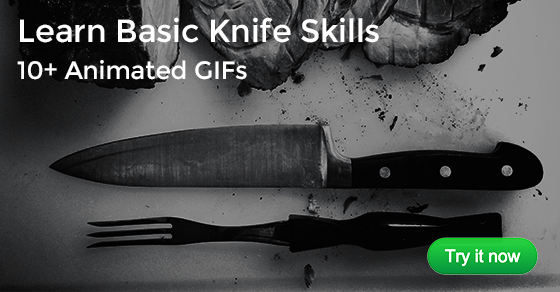Learning to cook is something that people can do to save money, eat healthier, and bond with their friends & family.
A major key 🔑 to success is knowing where to start. If you fumble around in the wrong areas, your cooking education can quickly lose steam.
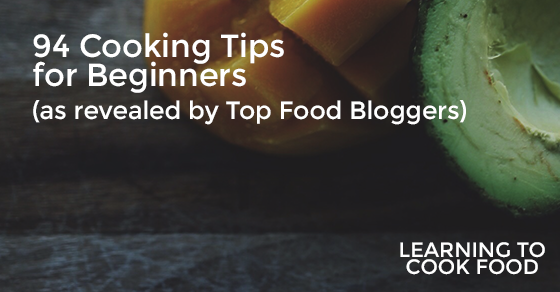
Below is a list of cooking lessons that 103 Bloggers 1 said they would teach themselves if they could go back in time. If you’re new to cooking, hopefully there’s some advice here that can help you become a better cook!
Browse by Category: Click any of the links below to jump to each category.
Knife Skills
Techniques
Flavors and Seasoning
Organization & Preparation
Using Recipes vs. Improvising
Equipment
Safety
Meal Planning
Mindset
Specific Dishes and Ingredients
Baking
Miscellaneous
Knife Skills
1. Take a knife skills class
Knives are an essential part of cooking, making it a no brainer to learn how to properly use them. They will cut down on your prep time. Even if you’re comfortable using a knife, consider investing 30 minutes to check if you’re using proper grip, form, and control.
2. Learn the difference between various knives
Understand what different knives are used for.
3. Select the right knife for you
Invest in a high quality chef’s knife right from the start, and learn how to to pick one that meets your needs.
4. Get familiar with basic knife cuts
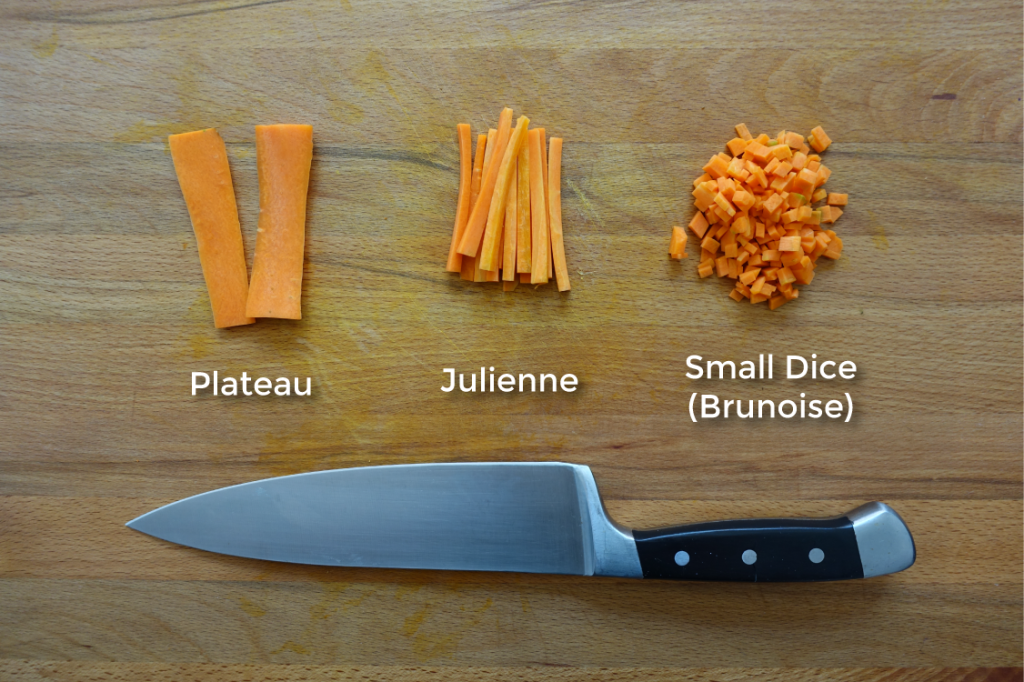
Even just learning a few basic cuts like the dice, chop, and julienne will go a long way towards becoming confident in the kitchen.
5. Learn the claw grip
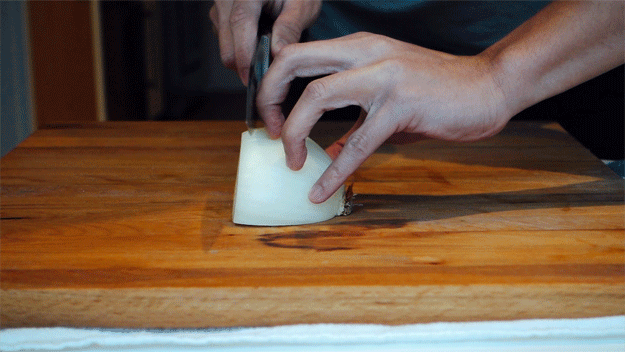
Use the claw grip to keep your fingers safe while cutting.
6. Practice knife safety
Brie of The January Glow says “If I could go back in time and teach my younger self a cooking class for beginners I would teach 3 lessons on knives! Safety first. I cannot tell you how many times I’ve put myself in danger by using the wrong knife.”
Jess of Hello to Fit says “This may sound too vague, but learning how to properly use a knife and cut/slice/chop. When I meal prep for the week, I need to be quick and efficient, yet safe. Holding the knife properly, as well as the object I’m cutting, is crucial!”
7. Keep your knives sharp
Kim of Jump, Jive and Kale! says, “Using a dull knife is not only dangerous, but obviously makes things much harder to cut. One way you can tell if your knife isn’t sharp enough is by seeing how well it cuts through a soft skinned fruit or vegetable like a tomato. It should glide through it easily with minimal pressure. ”
Jamie Geller of Joy of Kosher would teach herself “Knife skills, knife skills, knife skills! The foundation of cooking. If you have great knife skills you will enJOY cooking so much more and cut down on so much wasted time standing in the kitchen. But remember great knife skills require a great SHARP knife!”
Techniques
8. Learn techniques rather than specific recipes
T.J. from All Foods Considered suggests that new cooks “Focus on mastering general cooking techniques rather than mastering specific recipes… In other words, memorize techniques (and why they work) rather than memorize recipes.”
9. Learn how to steam and boil
Cherry Chu of Fruity Kitchen suggests learning techniques in a specific order: “First learn to boil, then steam, then use the oven, then pan/stir fry, and finally deep fry”.
Certified Holistic Health Coach Clare Brady emphasizes the importance of “basic cooking techniques that you can use for almost everything – steaming, boiling, sautéing, baking. These are super simple things, but can seem intimidating if you’ve never cooked!”
Steaming, boiling, sauteeing. These are simple things, but can seem intimidating if you’ve never cooked! via @fittingitallin Share on X
10. Learn how to sauté, braise & roast
Laura of Chronicles of Passion would “do a lesson on all the basic cooking methods, from sautéing to braising to roasting”.
Angela of LeMoine’s Family Kitchen mentions two of the same techniques, saying she would teach herself “sauteeing/braising/etc” because “When you know basic techniques you really can get adventurous.”
Chris Adams of State of Readiness shares some 👌🏽 sautéing tips:
- “When sautéing leave food alone and allow it to cook. It’s easy to want to constantly stir the food but allowing it to just sit and make contact with the heat really allows it to brown and develop flavor. Allowing the food to settle and cook is a good time to do some quick do-it-as-you-go cleaning. It’s also a great time to just be mindful with the present moment.
- Don’t overload the pan. Food needs space and airflow to cook well. Overloading the pan creates soggy food. Instead, batch cook or use two pans.”
Flavors and Seasoning
11. Salt your food throughout the entire cooking process
Jennifer of Seasons and Suppers stresses “the importance of proper seasoning – salt, in particular. When I learned to properly season my dishes, it was life changing.”
As Danielle of The Creative Bite says: “The first and most important thing I would do is teach myself how to properly salt my food. I grew up learning some of the basics of cooking from my mother who followed recipes to the very last detail. Therefore, the importance of things like properly salting your food throughout the cooking process was never conveyed to me. My very young self thought because I wasn’t a fan of salty food, that I didn’t need to salt my food. BIG MISTAKE! This tiny little step makes all of the difference in developing great flavors in your dish.”
12. Start a salt collection and experiment with it
The New York Times bestselling author Russ Crandall suggests starting a salt collection: “Kosher salt, sea salt, table salt, Hawaiian salt, Himalayan pink salt, smoked salt, and salt flakes all have different textures, flavors, applications, and levels of saltiness. Experiment with them until you find what works best for you.”
13. Learn how to “season to taste” with salt
Karen Petersen of 365 Days of Crockpot says to “always season to taste after food is cooked. A little salt can turn a mediocre dish into something amazing.”
Always season to taste after food is cooked. A little salt can turn a mediocre dish into something amazing. via @365dayscrockpot Share on XDenise Bustard of Sweet Peas & Saffron says that “Salt makes a huge difference! Always taste and add salt accordingly!”
Culinary Instructor Helen Rennie says to “Use Diamond Crystal Kosher salt (more about salt types) and learn how to season to taste.” — [In the 2nd video, she shares an experiment to learn how to gauge when a dish is perfectly or overly salted.]
14. Add flavor with herbs and spices
Lauren of Six Sisters’ Stuff shares, “A little seasoning can go a long way. There are so many ways to add flavor to even the most simple of dishes. Adding a little cilantro, basil, or thyme to some chicken can completely change the whole dish. I didn’t understand this until I was a little bit older, but cooking with spices and herbs is a game changer, and really pretty simple.”
In addition to “The Science of Garden to Jar Canning & Pickling”, Diane Baker of Canning and Cooking at Home says she’d want to teach herself “How to use Spices and Flavorings to enhance a recipe”.
15. Season with acids
Russ Crandall also offers this tip: “Season with acids as you would with salt and pepper. Often, your finished product may be missing a bit of ‘bite’ to it – adding vinegar, citrus, wine, or fish sauce at the end of the cooking process will often lend your dish that extra ‘something’ you were looking for.”
16. Discover what flavors work well together
Jessica of Plucky’s Second Thought says to “Be creative, but be knowledgeable. Know what foods with well with each other and what foods you can substitute when they’re just unavailable or you simply forget to purchase them when needed. Don’t be afraid to become creative with what’s available in your fridge or pantry. Obviously we’re not all chefs and have everything available to us 24/7, so we need to be knowledgeable about substitutions and what works well with other foods.”
Dana DeVolk of This Silly Girl’s Kitchen “would teach how to combine flavor profiles. When you start cooking you want to add a ton of different flavors together when normally, less is more.”
Laura Peill of Chronicles of Passion “would do a lesson in flavours: talk about flavour profiles, flavour combining, complimentary flavours etc.”
17. Balance a dish’s flavor by using multiple flavor components
Agnes Gällhagen of Cashew Kitchen shares some sneaky good advice for those who don’t have much experience around food: “A perfectly spiced meal needs all of the following components: sweet, savory, sour, umami. Even if you’re cooking something sweet, don’t forget the salt. And always add a dash of vinegar/lemon juice!”
Sarah Bond of Live Eat Learn adds, “Cooking is essentially balancing the 5 main flavors in different ways. The 5 main flavors are sweet (sugar), sour (lemon juice), bitter (dark chocolate, black coffee), salty (salt), and umami (savory tastes like seared meat, soy sauce, or aged cheeses). So try to recognize and play around with these flavors when you cook. Eventually you’ll come up with something magical!”
Organization & Preparation
18. Read through the entire recipe before you make it
MaryAnne of The Little Epicurean says: “When following a recipe, read all the directions before you begin cooking. Nothing is worse than finding out midway though a recipe that you were supposed to make a component ahead of time.”
Julie Evink of Julie’s Eats & Treats says “My biggest tip to anyone that’s just beginning in the kitchen is to read the recipe entirely before you start. I made this mistake so many times when starting and would miss a step or not be prepared. It was so bad it became an inside joke in our family!”
Jennifer from Seasons and Suppers would teach herself “To always sit down and read through a recipe before I start cooking it. I can make sure I have all the ingredients and I get an understanding of the process, before I’m knee deep into it.”
Mary of Bunny’s Warm Oven: “The first lesson I would teach myself is to not be overwhelmed by recipe directions that look long and complicated. Read through each recipe before you make it and visualize the steps in your head.”
Read through each recipe before you make it and visualize the steps in your head. via @bunnyswarmoven Share on XErin from Texanerin Baking suggests “reading the recipe twice before starting”. I love this because I’m a skimmer and this will force me to be more thorough at a crucial part of the cooking process.
Susannah of Feast and West says: “There are a lot of things I would teach my younger self! The first thing I can think of would be to read a recipe all the way through at least once before getting out a single ingredient. This is probably a no-brainer, but it’s something I still catch myself doing! I get toward the end and freak out. ‘Ack! I didn’t realize the cookie dough needed to chill overnight! I need cookies now!’”
19. Develop the habit of doing Mise en Place
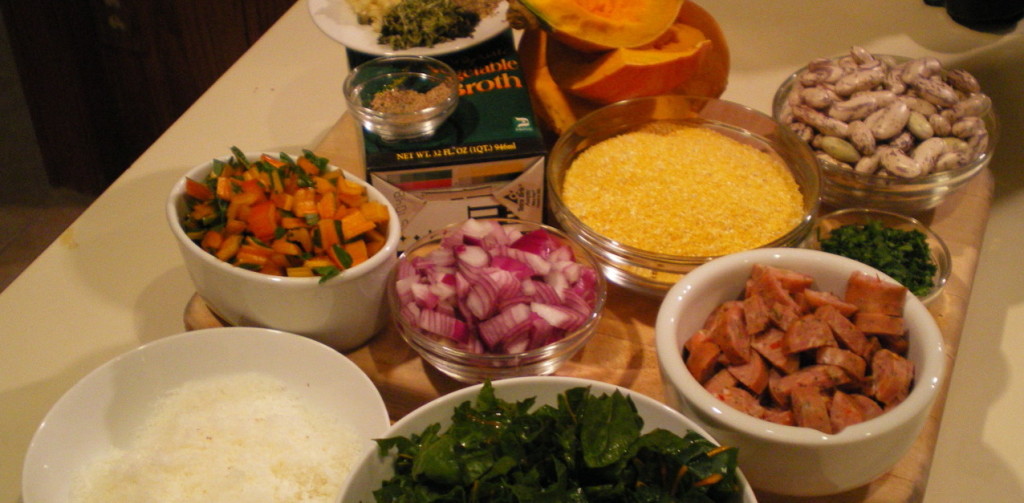
Siri Daly of Siriously Delicious describes the benefits of Mise en Place perfectly: “Prep your food. It makes it so much easier if you check out your recipe in advance and do all the chopping, cleaning, etc, ahead of time. I find it makes cooking a more calming and enjoyable experience that way! You can also put things in little prep bowls and pretend you have your own cooking show (um, I totally didn’t do that as a kid or anything).”
It makes it so much easier if you check out your recipe in advance and do all the chopping, cleaning, etc, ahead of time - @siriouslydelish Share on XIngrid Beer of The Cozy Apron says, “Do all of your ‘prep’ (your cutting, dicing, measuring your quantities, peeling, etc.) before you ever turn on your stove. Have a good work place (and a good, sharp knife—it’s safer!) where you have all your ingredients ready to just add into your recipe when it calls for them.”
Culinary School graduate Tessa Arias adds, “Nearly everything can be done ahead of time. Another lesson learned in culinary school!”
Susannah of Feast & West says to “practice mise en place. I tend to run all over the kitchen when I cook, making multiple trips to the pantry and cupboards while I’ve got a pot that needs stirring on the stove. Mise en place is the practice of measuring out all of your ingredients ahead of time, so you can focus on actually cooking instead of scrambling to find an ingredient.
George Bryant says he would teach himself to to “Prep EVERYTHING before I start cooking a recipe. That means having a plan or reading a recipe to ensure you have all ingredients and supplies needed.”
Katie Webster of Healthy Seasonal Recipes agrees: “Pull out all the ingredients you need before you start cooking.”
T.J. from All Food Considered says to “Practice ‘mise en place’ religiously. This means having all of your ingredients prepped before starting a dish as well as keeping a clean work station at all times. Organization in the kitchen is so much more important than most people give credit to.”
Kalpana Talpade says to “Keep everything you are planning to cook ready before you actually start.”
20. Learn to measure correctly
Christy Denney of The Girl Who Ate Everything says “I would definitely want to learn.. how to measure liquids and solids correctly”.
Gary House – currently attending Culinary School – recommends that people “Learn how to convert recipes quantity sizes” and also “to learn and become comfortable with measuring dry and liquid foods.”
Using Recipes vs. Improvising
21. Make recipes at least once as written
Katerina from Diethood always gives the same advice to those who ask: “Use a recipe as a guide – make it as-is the first time, but play around with it thereafter, to suit your taste.”
Erin from Texanerin Baking recommends “Before making any changes to a recipe, make it at least once as written!”
22. Experiment with ingredients to suit your taste
Nicky Corbishley of Kitchen Sanctuary says: “Get familiar with a few basic recipes and then tinker with them. Spaghetti Bolognese and chicken stir fry are a great starting point as they can be used as the basis for other recipes. For example – spag bol – make a spicy one by adding some chopped chilies, or a creamy one by pouring in a dash of heavy cream at the end. Or you could even make a large batch of bolognese sauce and then use some of it to make a lasagne for another meal. Chicken stir fry can be altered endlessly with different sauces, spices, vegetables, rice and noodles.”
The way Amber St. Peter explains it makes so much sense: “Experiment! Cooking is only fun if you love what you’re eating, so always add in more of the foods you love and take out the ones you hate. But don’t be afraid to try new combos…who knows what great flavor combinations you might discover?!”
Cooking is only fun if you love what you’re eating, so always add in more of the foods you love and take out the ones you hate @fettlevegan Share on XJanell of Saving You Dinero says she would teach herself to “Experiment with different ingredients – even if you don’t think they are the flavor that you like.”
Rebekka Steg of Becky’s Kaleidoscope says, “Learn a couple of basic recipes that you can easily modify… When you first start out cooking it is a good idea to follow your recipe closely. But as you advance, it is much more important that you learn how to alter and modify recipes to suit your taste – and the ingredients you have on hand. Knowing how to make a basic stew, you can easily change up the flavour by choosing different vegetables (or even fruits), spices, type of meat etc. Similarly goes for “dump” bread recipes, soups, meatballs etc.”
Cassie of Almost Getting it Together says she would teach herself to “[not] be afraid to use the recipe as a base and substitute as needed/wanted”.
Allison Walton of & be well says she would teach herself to “Experiment, experiment, experiment. Don’t feel the need to be so exact with measurements of ingredients. Feeling some fresh herbs and spices? Toss them in. Calls for peanut butter? Use cashew butter. Heck, make your own blend and use that. Your palate knows best, so unleash your creativity and don’t hold back.”
23. How to improvise & substitute ingredients
Amy Roskelley of Super Healthy Kids pretty much sums up my overall cooking goal — “If I could teach my younger self a cooking class for beginners, I would teach myself how to improvise! I am notorious for not having all the ingredients necessary to make a dish. Now, I’m very good at substituting or improvising, but it’s taken me a very long time!” 👍🏼👍🏼👍🏼
24. Experiment with lots of recipes…
Becky Blad says she would teach herself to “[Not] be afraid to try new recipes and ingredients I haven’t tried before. There’s always a chance you won’t end up liking it but more often than not you will find more recipes you love to add to your recipe collection and expand your taste buds.”
Grace Teo of Nyonya Cooking stresses the importance of not being afraid to try: “Even if a recipe seem difficult, don’t be afraid to try it out. Even if you fail, the next try would be better if it is not a success. I always seek for simple recipes when I first started cooking but the challenge in cooking recipes which are tougher makes you learn more and the satisfaction is much larger. Do not be afraid to substitute certain ingredients if you cannot find them. Living away from Asia and cooking Asians dishes does make it difficult. However, we have to make do with the resources that we have and try to make the best out of it.
25. …and master at least one.
Will Tully of Cooking With Kyler says, “Pick out a dish you really, really love to eat. Look up a few (or more) different recipes of that dish. Pick and choose the ingredients that really stand out and that you enjoy eating. Make your own recipe from your research and then master the heck out of it.”
Nicole Handler of Fitful Focus says her teachings would include “[Mixing] it up with spices – find a simple recipe that you love and know you can make well. Once you’ve mastered it, try switching up the spices. This will give the dish a totally new flavor without making anything more difficult for you.”
26. Follow your intuition
Katie Webster says to “Make sure that you use your cook’s intuition. Well written recipes will include both a degree of doneness (dark brown and bubbling) and a time range (5-7 minutes). Because stoves, ingredients, equipment, and knife cuts all affect the outcome of the recipe. Make sure that you use both indicators.”
I was intimidated by cooking for a long time, so I love this quote from Siri: “Trust your instincts! As children, we are constantly taught to follow the rules. However when it comes to food, recipes can seem intimidating and often turn people away from cooking in general. While following directions is typically a good thing, don’t be afraid to go off book and add a spice here, an ingredient there. Cooking is an art, so play with your creative side!”
Martin of Martin’s Peruvian Kitchen says, “Taste with your taste buds but also with your eyes, nose, heart and imagination.”
27. Taste your food as you’re cooking
Raquel from Organized Island says “My best advice would be to always always taste your recipe, even if you followed it step by step. Only you know what flavors you want to highlight so do not be afraid to add your own touch.”
Agnes Gällhagen of Cashew Kitchen says, “Smell, taste & feel what you cook. Let your senses guide you.”
Ingrid Beer adds, “Taste along the way, and allow your senses to guide you. Sometimes people freeze up like they’re performing brain surgery, or something really “life and death”; it’s just cooking! It should be fun! It’s important to check the flavors of things as you go, and add a bit more salt/pepper or other seasoning, liquids, etc. if needed; or watch what your food is doing, and let the sounds that it makes and the way that it’s looking/behaving guide you. The food will tell you what’s going on!”
Sometimes people freeze up like they’re performing brain surgery, or something really “life and death”; it’s just cooking! via @thecozyapron Share on XAussie Chef Duncan Robertson says, “Taste every dish “every time!” Get more than one persons opinion before deciding if it is good or not. Majority opinion always wins.”
Equipment
28. Equip yourself with the right tools
Jessica Cangiano of Chronically Vintage says one of the lessons that she would have enjoyed being taught as a youngster is “Invest in the best kitchen equipment that you can. It isn’t strictly necessary to produce a great dish, of course, but it typically helps on that front, often proves to be more economical in the long run (as it doesn’t need to be replaced as often, if ever), and will frequently give you more consistent (not mention beautiful/professional looking) results.”
Nicole Handler says that “A high quality blender is worth it – Once you really get into cooking, you’ll learn a lot about kitchen tools and gadgets. My #1 kitchen tool is my Vitamix blender. I use that thing every day. I remember trying to blend things in a regular $20 blender and it was just awful. I’d have to do everything in batches and in the end, it never fully blended. A high-powered blender will do the job in a quarter of the time, and it’s a piece of cake to clean.
Claire of The Simple, Sweet Life says she would teach herself “to tell the difference between multi-use tools and gadgets. These days, there’s a gadget for everything! But aside from cluttering up your kitchen drawers and cupboards, one-trick-pony gadgets aren’t particularly useful. Finding tools that you can re-purpose over and over again, now that’s what you want, but it’s not always easy to tell the difference. Having a discerning eye for creative kitchen tool uses really is an acquired skill.”
Jenné Claiborne of SweetPotatoSoul says she would teach herself “the importance of having great and often pricier kitchen tools (great spatula, food processor, blender, and wooden spoons)”.
29. Master the art of using a skillet
Russ Crandall suggests that beginners “Buy a 12-inch stainless steel skillet, and use it for everything – roasting, searing, sautéing, the works. This is one of the best ways to learning the temperature and timing required to properly cook food. For example – at higher temperatures, meat will generally stick to a steel skillet until it’s ready to be flipped.”
Allison Walton of & be well says, “If it fits into a skillet, then you’re golden. I truly believe that any meal can be made by investing in a single quality skillet. Whether you’re drumming up a batch of morning pancakes sizzling over coconut oil or fresh greens, veg and tempeh that can be lightly sautéed with a bit of olive oil and pantry herbs, you’ve won. You can even get fancy and make yourself some skillet oatmeal to serve among close friends and dig right in with a few spoons. See, golden!”
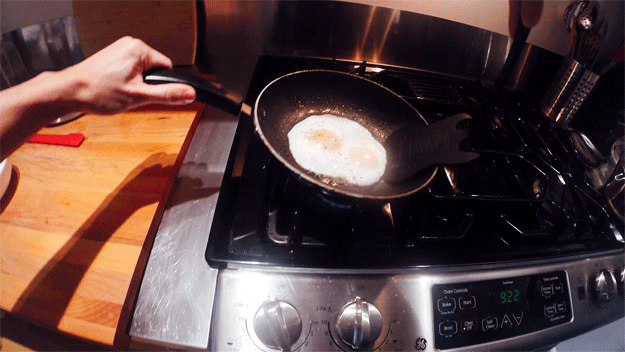
30. Learn how to use a slow cooker
Lauren of Six Sisters’ Stuff would like to go back in time and teach herself “A class on slow cookers. These can turn even the newest cook into a very skilled chef. There are so many options when cooking with your slow cooker. You can throw just about anything in there and be left with a result of a delicious home cooked meal. You can cook deserts, side dishes, and any kind of meat flawlessly. Anyone can cook, but not everyone is willing to try. Slow cooking is a great place to start.”
Anyone can cook, but not everyone is willing to try. Slow cooking is a great place to start. via @sixsistersstuff Share on XRegistered Dietician Jill Merkel says that if she could go back and teach her younger self a cooking class for beginners, she would teach “awesome crockpot recipes because it’s so easy to throw a meal in the crockpot and let it cook all day!”
Clare Brady also says to “get a crock pot. Crock pots are the easiest things in the world and can create delicious meals for even the worst cooks. Especially if time is short, these are life savers!”
31. Learn how to use a pressure cooker
Farah of The Cooking Jar says she would teach herself “how to use the pressure cooker and not be afraid of it. It’s a wonderful, wonderful time saver for tough cuts of meat and lentils. Anything cooks in about 15-20 minutes. It’s cheating in the kitchen with delicious results. It’s scary though, with all the racket it makes and all the warnings of how to handle it safely. But once you’ve mastered it, it’s a must have in the kitchen. Want some fall-of-the-bone Lamb Vindaloo in 15 minutes? Use a slow cooker. Want shredded beef from a cheap cut like chuck roast to make some beef tacos? Use a slow cooker and it’s ready in 15 minutes!”
Amy Roskelley also says she would teach a lesson on pressure cookers. Specifically, “How to use a pressure cooker for grains! Seriously the best investment I ever made! I love every single grain that comes out of that pressure cooker from quinoa to steel cut oats. I will never cook grains on the stovetop again!”
32. Choose the right pan
Helen Rennie says it’s important to “Learn how to choose the right pan. Stainless steel, seasoned cast iron, enamel coated cast iron, and Teflon all have their uses.”
Grace Teo of Nyonya Cooking says, to “Invest in Cooking. Being someone who is very careful with money, I always try to buy one of the cheapest knives, wok etc. However, a good knife does make you cut ingredients with ease. A good stainless steel pot is a real investment and can also last long enough. It took time until I learned that I had to invest in my kitchen tools.”
33. Overcome your hesitations about cast iron
Kim from Once a Month Meals says “First lesson I wish I’d learned sooner was to ditch the non-stick pans and use cast iron. I was always scared of them because I didn’t know how to clean or season them. But it turns out that they are often easier to use and clean than non-stick or stainless steel. And you end up with a much more flavorful dish in the end, which is worth it!”
34. Learn how to use food thermometers

Kim, a Registered Dietician, says to “Invest in an instant-read digital cooking thermometer. Although I’ve been cooking meat for quite a few years, I still can never tell when it’s done without cutting it open and letting all of the tasty juices escape. As a dietitian, I’m big into food safety and know the consequences of under-cooked meat. Getting an instant read thermometer makes it so easy to know for sure that the cooking time is done. I use the Taylor brand which is inexpensive and works well.”
Melissa Williams of Persnickety Plates says to “Buy an oven thermometer. My oven runs about 50° hotter than I set it, which makes a huge difference when cooking/baking!”
Safety
35. Develop safe habits in the kitchen
Laurel Stavros of A Bubbly Life highlights a safety tip that can be easy to forget: “I’d teach how to change batteries in a smoke alarm… my first year of learning how to cook I was a disaster!!”
Food-obsessed urban gardener Katie Sadler says to “Be careful when taking dishes out of the oven! Two arm burns and multiple lost dishes later, I think I am finally learning this one.”
Susannah of Feast and West says “I think a kitchen safety class would be so useful — I could always stand to brush up on these skills. The kitchen is filled with quite useful but also dangerous things, like knives and stovetops! It’s important to know how to handle them and to prevent (but also be prepared for) the inevitable emergency.”
Gary House reminds us to always be aware of what you are doing: “Know the safety rules in a kitchen, especially when handling sharp knives! I can’t tell you the number of times I have almost been cut by someone who has been careless with there knives. Burns, spills, splashes can easily happen if you are not aware of what you are doing at all times including watching what everyone else is doing.”
Meal Planning
36. Practice making weekly meal plans
Raquel Smith of My California Roots says “If I could go back in time, I would teach myself to make a meal plan for the week every single week. It helps me try new recipes and make sure I have enough time to cook.”
37. Take advantage of leftovers
Betty Givan of Betty’s Kitchen says she would teach a lesson on “How to package, refrigerate, and freeze leftovers to minimize waste”
Katie Sadler of BeNourishd says, “Always make enough to have leftovers, preferably with one or two portions for the freezer – it means you have home cooked ready meals and saves money, too.”
38. Learn to make freezer meals
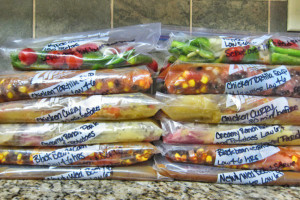
Kim from Once a Month Meals says “I worked full time when I was a newlywed, and we ate way more packaged foods and
frozen pizzas than I like to admit. I wish I had discovered the fine art of freezing my own healthy, homecooked meals back then instead of relying on the grocery store freezer aisle or fast food.”
39. Learn how to plan large meals
Betty Givan would teach a lesson on “How to plan a large meal (including holiday meals), all the way from creating the menu to the order of making the dishes for the meal.”
Mindset
40. Believe in yourself
Lauren of Six Sisters’ Stuff says “I think the first thing I would focus on is letting myself, or the others in the class know that anyone can cook. Everyone loves food and creating your own can be so much fun. Even the best chefs mess up from time to time, so burning a batch of cookies is not a big deal! I would start by showing them some really simple 5 ingredient or less recipes that they can make with ingredients they already have in their kitchen. Cooking really can be so simple, there is no need to add complex ingredients or steps to make it fancy.”
41. Relax and have fun
So many positive words of wisdom in this area!
Tiffany (of The Gracious Pantry) with a 🔑 reminder: “I would say the number one thing to remember is that it’s okay to mess up in the kitchen. That’s how you learn, by making mistakes. Don’t take cooking too seriously. Play with your food!”
It's okay to mess up in the kitchen. That's how you learn, by making mistakes. via @graciouspantry Share on XAmber St. Peter of Fettle Vegan says, “Don’t get frustrated or overwhelmed. Cooking should be fun.”
Angela LeMoine says, “Just experiment! Try new recipes from cookbooks, throw things together you have on hand, be creative- you never know what may turn out great. If it ends up being a fail, oh well, now you’ve learned something”
Denise Bustard says, “Have fun! I always looked at cooking as a chore when I was younger, and it wasn’t nearly as much fun as it is now when I’m experimenting with new cuisines, different ingredients, techniques, etc.”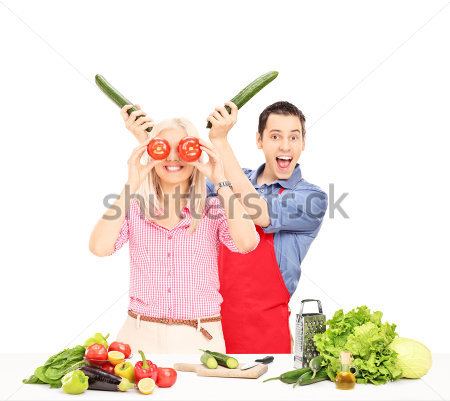
Rebekka Steg of Becky’s Kaleidoscope says “Don’t be upset if a new recipe doesn’t work out – mistakes are learning experiences too: Whenever I try a new recipe I see it as a learning experience. If it works out well – wonderful! If it doesn’t, I’ll take a look at what parts went wrong, what about the consistency or flavours don’t I like. Sometimes it might just need a little tweaking to turn out better the next time – other times you just have to say “that’s not for me”, and move on to the next thing.” 👏🏼👏🏼👏🏼
Chris Byers of CookingforDogs says, “Cooking is an art not a science and should be fun so think outside the square and enjoy.”
42. Be patient with your progress
Becca Davis of Two Places at Once says “I would teach my younger self patience. So many recipes go wrong for various reasons. And it’s ok. I can be so hard on myself when a recipe doesn’t come out perfectly. It’s not worth the stress! The whole point of cooking is to enjoy making food and enjoy eating with the people you love. When I’m cooking something for the first time or learning a new technique, I remind myself to be patient because new things take time.
43. Be patient with your ingredients
Chandra Lane-Sirois of The Plaid & Paisley Kitchen says, “Most importantly I wish I had patience back then. A watched pot never boils, just as constantly opening the oven to check only adds more time to the cooking process. The best advice I can give to new cooks is be patient. Slow down, read your recipe, drink a glass of wine and let the oven do its job. A watchful eye is ok but looking every 5 minutes could very well ruin your dish.”
44. Stay dedicated & persistent
Julie, Maddie & Kinslee of Tastes of Lizzy T share some simple advice:
- “Don’t give up. Learning to cook takes time.
- Don’t be afraid to try something new. You may fail, but you you’ll never have the chance to succeed unless you try.”
45. Don’t worry about making mistakes
Jessica Pelasky says “Don’t be scared. Learn to try anything and everything because you just never know what food combination or styles you like unless you try them. Many different types of food have a completely different taste depending on how they’re cooked and what they’re cooked with. So definitely be comfortable when tasting different types of foods.”
Janell of Saving You Dinero adds, “I would tell myself to not be afraid of recipes that looked like they could be difficult. Just go ahead and try it at least once.”
46. Good enough vs. Perfection
Christine Byers says, “Near enough is good enough – perfection is stressful (unless you’re a heart surgeon). Be confident and give it a go.”
Tessa Arias adds, “It doesn’t have to be perfect. In a professional kitchen there’s so much chaos that making a dish never goes perfectly from start to finish. You may not have an ingredient, you may be missing a piece of equipment, or you may have messed up a step in the recipe. I learned in culinary school that you can almost always make it work regardless of what happens! And in finding ways to make things work, you end up learning so much that your kitchen confidence soars.
47. Expect to make mistakes
Marie of Not Enough Cinnamon says “It’s okay to fail a recipe. Actually, it’s recommended. Don’t feel bad if you burn your dish or if it tastes horrible. It’s the best way to learn.”
Don't feel bad if you burn your dish or if it tastes horrible. It's the best way to learn. via @necinnamon Share on X
Ali of Home & Plate adds,”Plan to fail at some point because that’s how you improve. But try try again.”
48. Know yourself and what you enjoy preparing / eating
Ingrid Beer of The Cozy Apron says, “First you must think about what you feel intuitively like you’d enjoy preparing and eating. Get “in touch” with yourself! Use your imagination, or do some research (or use a recipe, of course, if you’re a beginner as a guide), and make a list of the ingredients. This is the easiest way to shop!”
Specific Dishes & Ingredients
49. Become a master of 5 ingredients
George Bryant: “Become a master of 5 ingredients. When learning how to cook I was overwhelmed with all the possibilities and choices so keeping the selection limited to 5 at a time builds confidence.”
50. Learn how to stock your pantry
Becca Davis says “Stocking a pantry may seem like a pretty easy thing, but it’s a difficult task to master. You really have to evaluate exactly what foods you like to cook, what goes into those foods and how you will make them. It’s so much more than just keeping a grocery list and going to the store. It’s a skill! Having a properly stocked pantry helps create your identity has a chef. And if you’re cooking on the fly, you can be confident with what’s in your pantry.”
Laura Stavros would also teach a lesson on “Stocking A Pantry with the Basics- a well stocked pantry can pull together a ton of meals! ”
51. Understand when to use different cooking oils (and butter)
 Danielle Heckman of Glitter Spice says that one thing she wishes she knew when she first started cooking is “How to use different cooking oils. When I first started cooking I used olive oil for everything. I had no idea that it burned really easily and that is was sabotaging a lot of my dishes. Just by having a very small understanding to the smoking point of a few of the most commonly used oils, would of saved me a lot of cooking headaches.”
Danielle Heckman of Glitter Spice says that one thing she wishes she knew when she first started cooking is “How to use different cooking oils. When I first started cooking I used olive oil for everything. I had no idea that it burned really easily and that is was sabotaging a lot of my dishes. Just by having a very small understanding to the smoking point of a few of the most commonly used oils, would of saved me a lot of cooking headaches.”
Farah of The Cooking Jar shares a 💰 tip on pan frying: “The absolute first thing I would teach my younger self would be that the oil must be hot and ready before you even think of pan-fry anything! I can’t tell you how much stuff stuck to the pan and how much breading stripped off food simply because I was too impatient to wait for the oil to get hot. It sticks, it ruins the food and sometimes it makes the food way more oily than it should be. Test if the oil is hot by tossing in a morsel of food. If it starts crackling, it’s ready.”
Kit Graham of The Kittchen says, “Use grass-fed butter it has more flavor and you can even buy grass-fed butter with herbs in it.”
Lauren Grier adds, “Clarified butter is your friend. It has a higher smoking point (500 degrees!) and is easy to make.”
Ashton Swank of Something Swanky on the importance of using real butter: “Margarine is different than butter!!!!!! It took me a long time (TOO LONG) and who knows how many batches of gross cookies to realize that. Always use REAL butter. Always.”
52. Learn how to cook without oil
Nichole Dunst of Green or Die says, “You don’t need oil to cook! Oil is not a whole food and, in my opinion, we undo a lot of the good we do by eating vegetables and greens and other alkalizing foods when we douse them in oil. But the good news is, you don’t need it! To sauté vegetables, simply add water or (for more flavor) vegetable broth to the pan before adding in your veggies. This will save you a lot of unwanted fat and calories. To top off salads, make a tahini based dressing by blending equal parts tahini, water and fresh squeezed lemon juice. The fat in tahini will help with nutrient absorption, plus tahini has dietary fiber and other important nutrients like calcium, zinc, selenium, and iron.”
53. Invest in spices
Rachel Pattison of Little Chef Big Appetite says, “Invest in spices. So many of my friends tell me that they won’t cook a recipe if it requires them to buy new spices OR a friend will cook a recipe, leave out a few of the required spices and then say that it turned out terribly. There’s an easy fix — stock up your spice cabinet! Spices add incredible flavor and depth to a dish WITHOUT adding calories and fat. Trader Joe’s sells many spices at great prices – I recommend starting there if you have one in your area.”
54. Get familiar with the smell & taste of different fresh herbs
Hannah Whitcomb of Clean Eating Veggie Girl would teach herself “The importance of cooking with fresh herbs (now that I know how much better things taste with fresh herbs, I cannot go back).”
Will Tully adds, “Familiarize yourself with all fresh herbs. Get to know the smell and the taste”
55. Practice peeling garlic
Kim (Jump, Jive and Kale!) says she would teach a lesson on “The easy way to peel garlic. Place the garlic clove on a cutting board, get out your chef’s knife and lay it flat over the garlic clove. Using your fist, smash the knife onto the clove with one quick motion. The peel will come right off!”
56. Get familiar with cooking vegetables
Karen Petersen of 365 Days of Crockpot says “Roasted veggies: almost any vegetable is delicious with a bit of olive oil and salt and pepper and roasted in the oven. It’s the easiest and the most delicious way to serve veggies.”
Tomasz of Ron’s Kitchen would teach a lesson specifically on “How to cut onions”
57. Learn how to make plant-based meals
Nichole Dunst of Green or Die says “Anything you can eat, I can eat vegan. Eating plant-based is the way to go in order to help us to feel, look, and live our best. And it can be so delicious, too.
If I could go back and teach my younger self how to create beautiful dishes that are good for the mind, body, and soul, I would let myself in on all of the ways I can substitute animal products for health-promoting plant based ingredients.
- Heavy Cream- Make cashew cream by blending 1 cup raw, soaked cashews with 1/4 to 1/2 cup water, depending on desired consistency.
- Butter- Substitute avocado
- Oil- substitute organic applesauce
- Egg- Make a flax egg by mixing 1 tbsp ground flax seed with 3 Tbsp of water then leaving to sit in the fridge for 15 minutes.
- Meat- Cook tofu or lentils with similar seasonings as you would cook meat with. I find that a lot of times, what people like the most about meat dishes is not actually the meat itself but the spices and seasonings we cook them with. You can cook mushrooms, lentils, tofu, and other heartier vegan foods with similar spices and vegan dressings to get a similar effect. One of my favorite dishes is a lentil sloppy joe that I swear tastes just like the real thing!”
Jenné of SweetPotatoSoul says she would teach herself “how to bake without having to rely on animal products (especially butter)”.
58. Learn how to cook eggs in different ways
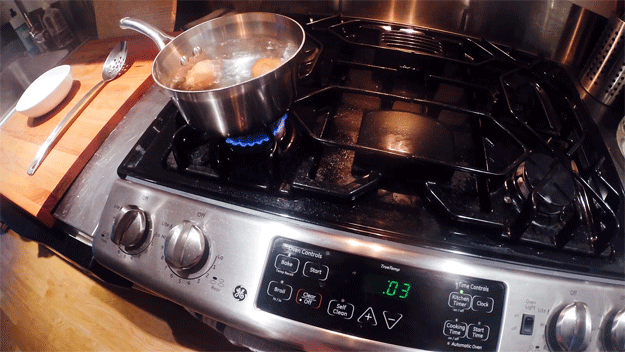
Will Tully on eggs: “Practice making eggs. Prepare them as many ways as you can. Scrambled, fried, over easy, omelette, hard-boiled, etc. Get comfortable with the process.”
Jennifer of Take Two Tapas would teach a lesson on “How to properly hard-boil an egg”.
Teri Schuler of The Freshman Cook would teach one on “How to bake the perfect egg”.
Tieghan Gerard says that in addition to properly use a knife, one of the things she would have liked to have known most – when learning to cook – is “how to properly cook eggs”.
Soni Sinha of soni’s food says she would teach herself “How to cook basic foods such as scrambled eggs, boiling pasta, potatoes, rice etc..since those are the easiest to make and very simple.”
59. Learn how to cook seafood
Hannah Whitcomb says she would teach a lesson on “How to properly season and cook seafood (I probably would have started eating seafood a lot earlier on in my life, had I known how to cook it)”.
60. Learn the ins-and-outs of cooking chicken
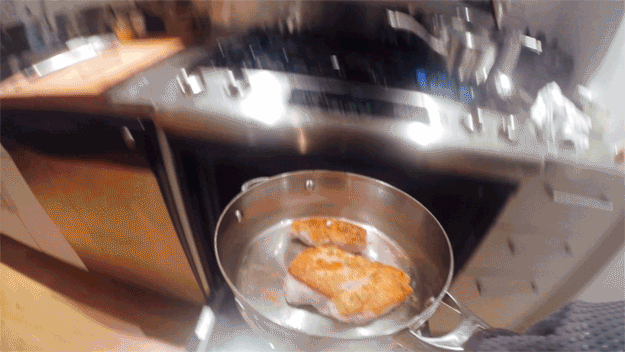
Laurel Stavros would teach a lesson on “How to Roast a Chicken- I just think once you roast the perfect chicken, your confidence raises!”
Danielle (The Creative Bite) says, “I would learn how to cook a chicken breast to perfection. It sounds so simple, but the very important step of tenderizing the breast and seasoning it properly go a long way in producing a perfectly tender and juicy chicken breast.”
Carla Cardello of Chocolate Moosey says, “Don’t be afraid of bone in, skin on chicken breast. Deboning may seem scary, but you’ll get the hang of it after a few tries. Not only is buying bone in chicken breasts cheaper, they are much more flavorful than buying boneless skinless chicken breasts.”
Liren Baker of Kitchen Confidante would teach herself “how to roast a chicken. It is the simplest and most satisfying dish to make as a first time cook, and it’s something you will make for the rest of your life. Plus, there’s leftovers!”
MaryAnne Cabrera says, “Learn how to break down a whole chicken. You should be aware that the chicken is a whole bird, not just the prepackaged breasts and thighs readily available at the market. Purchasing the whole chicken is often cheaper, plus you have more to work with. Bonus: you can use the bones to make homemade stock!”
Kim from Once a Month Meals adds “…learning how to spatchcock and roast a whole chicken has been a game changer. I always shied away from cooking a whole bird because it took so long. I never had time to do it when I got home from work. Now I can roast the perfect bird, complete with crispy, brown crust in about an hour. Just cut out the spine with kitchen sheers, flatten the bird in the pan, and rub the seasoningunder the skin. Roast at 425 degrees for about an hour or until it reaches a safe internal temp and the skin is nicely browned. You have lots of leftovers and you can make stock with the bones.
61. Learn how to cook other types of meat
Teri Schuler would teach her younger self “How to purchase and cook a roast”.
Jennifer of Take Two Tapas would teach herself “How to make pork chops that don’t dry out”.
Melissa Williams would teach a lesson on “How to bake bacon in the oven. So much better than having grease splatters everywhere & it turns out great!”
Chandra Lane-Sirois says, “Thinking back to my first apartment kitchen when I was 19, I can tell you that I wished I learned how to brown meat properly before cooking it in any other way. Now whether I am slow cooking, braising, or roasting I always season and brown my meat first.”
Lauren Grier of Climbing Grier Mountain would teach herself to “Bring meat or other proteins to room temperature before you cook. It will ensure even cooking!”
62. Learn how to tell when meat is cooked
Cherry Chu would teach a lesson on “How to tell if meat is cooked. 2 lessons into my course, I was asked to make pork chop, mine looked perfect on the outside and totally raw on the inside. But I didn’t even know coz I didn’t know what raw meat looks like.”
Tieghan Gerard of Half Baked Harvest: “Do not cut into meat without letting it rest.”
63. Learn to make a simple roast dinner
Nicky Corbishley: “Learn to make a simple roast dinner – (roast chicken, roast potatoes, a couple of veg and gravy). Search for or write a timeplan, and then make it often until you’re comfortable. This helps get you used to cooking several things at once, and also provides a sense of achievement that you’ve cooked a well-rounded meal. Once you can confidently cook your roast chicken dinner, up the game by adding other accompaniments – other veg/stuffing etc. Next step is trying a different meat!”
64. Learn how to properly cook pasta
Manuela of Cooking with Manuela says that one of the many cooking lessons her younger and inexperienced self could use is “how to properly cook pasta. Pasta is such an easy and fun ingredient to work with. My go-to, one-dish dinner that I can always pull together at the last minute with what is available in my refrigerator. I’m Italian, so I’ve pretty much always been able to cook decent pasta. What I learned over time, though, is to make it perfect, and not just for myself but for the people I cook for. If you are like me and like your pasta al dente, make sure to set the timer for one to two minutes less than what indicated on the box. You will need time to taste the pasta and drain it. And remember that it will continue cooking and getting softer if you toss it back in the pan with the sauce. You also need to be flexible and, when you cook for other people, need to keep in mind their taste. Not everybody likes their pasta al dente as much as I do!”
65. Learn how to make some sauces
Amber Spiegel of SweetAmbs did take some of beginners cooking classes and says if she could go back and tell herself to pay more attention in some of the lessons, she would choose “The 5 Mother Sauces”.
Christy Denney says “I would definitely want to learn about how to make basic sauces”.
66. Learn how to make a great dessert
Aimee of Twigg Studios says “I would teach how to make the perfect bread dough as that can be adapted for so many different recipes. The second thing i would teach is how to make the perfect sponge cake, it took me a while to learn to be gentle when mixing in the flour so you don’t get a dense sponge. And number three I would teach how to make pastry cream as knowing the consistency of this can help when making other things like lemon curd and Ice Cream.”
Malery of Maly’s Kitchen says she would teach herself how to make an easy Dominican cake: “Coming from a a Dominican background, this was the cake I was so fascinated about as a kid. I loved the flavors, the texture, and the look of it. I wanted to know exactly how to make it, but to me it always seemed so complicated! If I could have taught myself to make this dessert, I would have shown an easy way without using traditional methods.”
Manuela of Cooking with Manuela: “I absolutely love sweets, so my last lesson would be on how to make an easy and irresistible dessert. Maybe a rich and creamy tiramisu or crème brulee. Or a fun and colorful fruit tart. Either way, easy is again the key word. And unless you know what you’re doing, stick to the recipe. No substitutions and no shortcuts. Even if you think that baking powder is pretty much the same as baking soda, and looks a lot like corn starch. Stick to the recipe, and again, keep it simple. I still remember one of the first birthday cakes I baked for my husband, many years ago. A three layers dessert, with a made-from-scratch sponge cake (not so spongy), homemade puff pastry (not really puffed) and an ok tasting custard cream sprinkled with chocolate chips. Let’s just say… memorable!”
67. Learn how to cook rice on a stove top
Heidi of Crock-Pot Ladies says if she could go back in time and teach her younger self a cooking class for beginners, one of her lessons would be on “cooking rice on the stove top (hello rice cooker!)”.
68. Learn how to make soup
Liren Baker says “I would do a lesson on soup basics. This is another fundamental. Once you can make soup, you will always be nourished.”
Once you can make soup, you will always be nourished. via @kitchconfidante Share on XKanak Khathuria says if she could teach a cooking class for beginners, she would teach herself how to make “Healthy and Nutritious Vegetable Soup”
69. Learn how to make bread
Sophia Purvis of Little Box Brownie would teach a lesson on “How to make bread and the importance of kneading it and knocking it back”.
Stephanie of Daily Appetite would also teach “Bread making. Why on earth did I not just take a bread making class? I love bread but it took a long time for bread to love me back.”
Diane Baker of Canning & Cooking at Home would also teach a lesson on “How to properly bake bread without a bread machine”.
70. Learn how to make gravy
Jennifer of Take Two Tapas would teach herself “How to make gravy that is not lumpy”.
Kit Graham would teach herself to “Freeze extra gravy and add it to soups”.
71. Learn how to make pizza from scratch
Malery from Maly’s Kitchen would teach herself “An easy way to make Pizza from scratch. When I was younger, I was obsessed with the idea of working with yeast dough (and still am!). It’s something I could do for hours, even if I wouldn’t be making something specific. I was also obsessed with Pizza, (but who isn’t)?! I never knew how to prepare it, with the rising, and the waiting…etc. I would have been awesome to learn how to make it from scratch.”
Baking
72. Take a baking class!
Dana DeVolk “would do a basic baking class, because I was super intimated by baking and it turns out, it’s not that hard!”
73. Learn the basics of working with flour
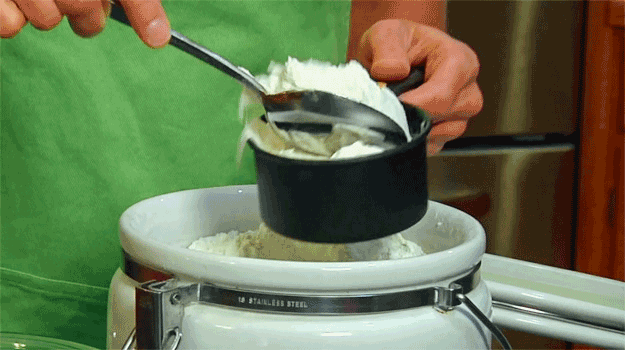
Amber Brady of Dessert Now Dinner Later says one of the most important lessons for beginners would be “To learn to measure flour properly for baking to prevent dense, heavy baked products.”
Julie, Maddie & Kinslee of Tastes of Lizzy T say, “Sifting flour is important. I never used to take the time to do it, but it is so important, especially when you are combining cocoa powder and flour. It helps the ingredients to combine evenly.”
Malery of Maly’s Kitchen says “When I first began baking, most of my fails were due to simply not preparing ingredients properly. It was something that could be easily avoided if I were told what to do and what NOT to. For example: making sure never to pack flour into the measuring cup, rather to just lightly scoop it in..or always remembering to check butter for freshness. I once made cupcakes for a school party, and because I didn’t check my butter, they turned out tasting like everything in my fridge! Whoops..? This is something that could have been avoided if I knew a few basic tips. However, It was a pretty funny learning experience (well, no one ate them).”
74. Make sure to be super-precise when baking
Tessa Arias says, “Baking is all about PRECISION. With cooking you can afford to get creative and even make mistakes without ruining everything. On the other hand, with baking you need to be precise down to the last measurement and degree of temperature. For anyone looking to improve their baking, get yourself a scale to measure your ingredients and an oven thermometer because most home ovens aren’t very accurate. Everything will turn out better with just those two things!”
Gary House adds, “There is a difference between baking and cooking – baking is a science and you have to measure your ingredients exactly, cooking is an art and you can be flexible when adding ingredients to taste.”
75. Learn how to make pie crust
Carol Borchart of A Chef’s Kitchen would teach “How to make pie crust. My mother’s pie crust was so flaky, it shattered like glass when you cut into it. Evidently this trait skips a generation, because I’m still scared to death to make pie crust!”
76. Learn how to make specific sweet treats
Sophia Purvis would teach her younger self “How to make a creme anglaise so I could make amazing ice cream” and also “How to cream the butter and sugar to make great cakes.”
Liz Berg of That Skinny Chick Can Bake says that since she loves to bake, she’d teach these 3 lessons:
- How to make a meringue—which can then be used for meringue cookies, pavlovas or to top a pie. I’d share a number of tricks to help ensure a perfect result.
- How to make a simple drop cookie, like chocolate chip cookies including the order of ingredients, mixing technique, plus baking tips like having your butter and eggs at room temperature.
- How to make muffins and quick breads—only one bowl needed and the options are endless! I’d showcase both sweet and savory loaves, from pumpkin bread to Irish brown bread, made without yeast.
Amber Spiegel attended The Culinary Institute of America for baking and pastry and says if she could go back and tell herself to pay more attention to some of the lessons, she’d choose the ones on “Yeast Dough” and “Pastry Cream (I still have trouble making it perfectly smooth!)”
Claire of The Simple, Sweet Life says that if she could go back in time and teach herself a beginner’s baking class (which is her focus), she would teach herself:
- “…how to frost a perfectly smooth cake with crisp, clean edges. I think people take a perfectly smooth cake for granted, but make no mistake, it takes skill, and more skill and time than you might think!”
- “…a crash course in royal icing and it’s consistencies. Royal icing can be a wonderful medium for all kinds of decorating, but mastering it’s consistencies and their uses takes time! Not just because you have to learn how to get it just right, but because it can be really difficult to explain various consistencies. If it’s supposed to have a tooth paste consistency, are we talking gel or paste? And when someone says 20 second icing, how close to the 20 second mark do we have to be? Everyone seems to have a slightly different way of describing consistency, and it’s hard to know what’s right without feeling it (or going through lots of trial and error).”
Miscellaneous
77. Keep it simple
Kathi of Laughing Spatula says “I would cook more basics and stay away from the fancy stuff. Learn to make a good roux, a great béchamel, grilled veggies and simple dressings. Simple, high flavor foods. I think as a young cook I wanted to make all those pretty foods I saw in pics without learning the basics first. Fancy comes later.”
I wanted to make all those pretty foods I saw in pics without learning the basics first. Fancy comes later. via @LaughingSpatula Share on XNicole Handler says “Keep it simple – When I decided I wanted to cook more, I was all about the complicated recipe. I figure it would taste better and really show off my skills. Over the years, I’ve learned that this just isn’t true. Complicated dishes can be great, but some of the best recipes have less than 5 ingredients and take under an hour to make. Why stress out over multi-step recipes that will take you a day in the kitchen when a simple one will be just as good, if not better? When you’ll looking up recipes, use search terms like, “one-pot meals” or “simple” to find some good ones.
Marie of Not Enough Cinnamon says “Start with very simple recipes and gradually build up your confidence towards more advanced recipes.”
Jennifer of Seasons and Suppers says “To try not to be too creative, too soon. Cook and bake recipes as written first and for a while. Learn from more experienced cooks. THEN, look for ways to bring your own creativity to cooking.
Chris Adams of State of Readiness says, “Complicated and fancy is great and can be really fun. But for sustainable, healthy cooking I like to stick with simple and easy. It’s easy to get burned out when trying to create and explore novel food options. I’ve found that using a few, simple standby cooking methods, that can be adapted for different flavored or ingredients, helps to keep me on track for my nutrition goals. When I’m tried and hungry I don’t have to think to hard, or put in much effort into what I’m doing.”
Becky Blad says, “Learn how to make simple and quick dinners like quesadillas, pasta, grilled chicken for salad etc., and other quick and healthy meals.”
78. Get comfortable with managing heat
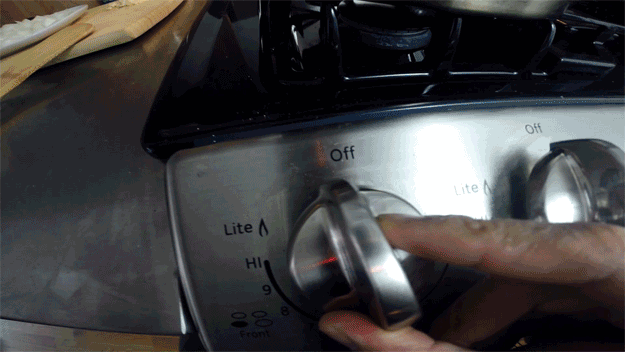
Joe Borio of Cooking Italian with Joe says he would teach a lesson on “management of heat – making sure things are cooking at the right temp – to start at a higher temp then lower the heat to keep the meat moist”.
Make sure things are cooking at the right temp - start at a higher temp then lower the heat to keep the meat moist. via @cookinwithjoe Share on XGreg from Greg’s Kitchen says “Cooking doesn’t have to be about fancy products or expensive machines, it’s about making something edible out of a few basic products so you don’t starve to death. If there is one piece of advice l can give, it is PRE HEAT YOUR OVEN! The rest is easy after that.”
Lauren Grier: “Don’t be scared of heat! Searing meats, vegetables, etc. give the ingredients more flavor.”
Caroline Kaufman: “Don’t trust the nob on your gas burner. I know the nob says things like “high,” “medium,” and “low” on it, but it may not actually correspond to what your flame is doing. I used to burn things all the time because I’d put the nob on “medium,” like the recipe said, not realizing that the flame was still really high.”
Marisa McClellan of Food in Jars says to “Always pre-heat. The oven, the saute pan, and even the roasting pan. Everything tastes better when cooked at the right temperature.”
79. Clean up as you go
Erin Dee (Texanerin Baking): “Clean up as you go. This is something I never learned and end up suffering when I have an hour of dishes after a baking session. If you start off cleaning as you go, it’ll become more of a habit rather than a huge struggle that you have to try to learn (and fail at!).”
Kalpana Talpade: “Cleanliness. Give a lot of importance to cleanliness. Wash your hands before starting to cook. Check if the plates, knifes, table, etc. are clean. This habit will keep you healthy for lifelong!”
80. Focus on what you’re doing
Agnes Gällhagen: “Smell, taste & feel what you cook. Let your senses guide you. Be in the moment and don’t try to facebook/tidy up/set the table at the same time.”
Marisa McClennan: “Pay attention. Trying to do too many things at once leads to burnt food and cut fingers.”
Pay attention. Trying to do too many things at once leads to burnt food and cut fingers. via @foodinjars Share on X81. Learn good sanitation habits
Gary House: “Sanitation is critical! Being careless with food, equipment and storage can easily put someone in the hospital or worse!”
82. Cook with the seasons
Danielle Heckman wishes she knew about “Cooking with the seasons. When I first started cooking, I just went to the grocery store and bought whatever was required for the recipe that I was making. As my cooking started to evolve I began shopping at farmer’s markets and started to notice what was in season based on what was available at those markets. I realized that I could still make my favorite dishes anytime of the year, but I challenged myself by getting creative and tried to use what was in season. My dishes ended up tasting so much better by cooking with ingredients when they are at their peak.”
83. Practice recipe timing
Heidi from Crock-Pot Ladies would teach her younger self a lesson on “recipe timing (I always struggle getting a multi-dish meal on the table at the right time)”
Cooking doesn’t have to be about fancy products or expensive machines, it’s about making something edible out of a few basic products so you don’t starve to death.
84. Expand your horizons through grocery shopping
Jessica Cangiano says “This one certainly doesn’t apply to the same degree any more, thanks in no small part to huge array of products that can be purchased online nowadays, but…there are so many more amazing ingredients (and recipes) out there than what your own small town has (or may have) to offer. Just wait until you get to explore a whole vast world of ingredients. It’s going to be like culinary fireworks, I promise!”
Katie Urban of A Touch of Teal shares, “One of the best tips I ever heard when I was learning how to cook was to shop at a different grocery store each week. This way, you’re constantly introduced to new foods and ideas, keeping you inspired and out of a going-out-to-eat-all-the-time rut.”
Sarah Bond of Live Eat Learn says a lessons to her younger self would be “Experiment with 1 new ingredient each week/month/whenever you go to the grocery. My whole blog centers around cooking with new ingredients, and my cooking has expanded so much because of this! Nature gives us so many tasty ingredients to work with, so find something new and interesting, find a recipe, and experiment with it!”
85. Love what you’re doing
Mary of Bunny’s Warm Oven: “LOVE what you’re doing! Learning something you love to do makes it a pleasure.”
86. Learn the science of cooking
Duncan of Duncan’s Thai Kitchen: “Cooking is 80% science. Understand Acid, temperature, protein development, fats, and heat control. Only 20% is art: colour combinations, structure, size and presentation People will remember how the food tasted more than what it looked like.”
87. Use the best ingredients
Rachel Pattison says “Use whole foods. When I first started cooking and eating healthier, I always fell for products like fat-free cheese and 45 calories-per-slice bread. Because I thought these products were “healthier,” I ate more than I should have, which did nothing to benefit my weight. Plus, these products were always bland and left much to be desired. Today, I much prefer to use real products (e.g. full-fat cheese and seeded whole wheat bread), but I just eat everything in moderation. I’m a healthier person and my taste buds are much happier.”
Martin of Martin’s Peruvian Kitchen adds, “From day one ask yourself ‘where does this ingredient come from? Is it sustainable? Is it organic? Who made it and under what conditions? And always demand freshness.”
88. Make your dishes visually appealing
Ashton Swank says “People like pretty food. It’s true when they say you eat with your eyes first. So always press chocolate chips/M&Ms/etc into the top of your cookies right after they come out of the oven. It makes the HUGEST difference!
89. Learn some helpful kitchen hacks
Lexi Kornblum of Lexi’s Clean Kitchen says she would teach herself some “simple kitchen hacks that everybody should know (like juicing a lemon easily, removing egg shells that fall in, dicing an avocado, and more)!”
90. Learn simple ways to cook vegetables (so you can eat more of them)
Jill Merkel of RunEatSnap says, “quick and easy ways to cook veggies so I would eat more of a variety of veggies and started liking them from a younger age”
91. Don’t think of cooking as a chore
Ali of Home & Plate says, “Have fun. Cooking should not be a chore. Cleaning the dishes is a chore.”
92. Learn the joy of wine pairing
Chris Urbano of Maputing Cooking says that in addition to knife skills and the fundamentals of how people taste, he teach his younger self “the joy of wine pairing. I love wine and food together, and when you get the perfect pairing between the two it elevates the entire meal to a new level of excellence. Most people don’t try it, but you can actually pair wine to just about any Filipino food. Except for Sinigang!”
93. Document your journey 📷
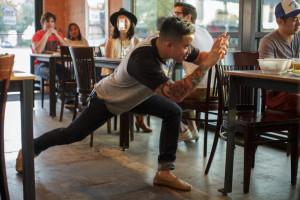
Jessica Cangiano: “Take lots of photos! It’s normal nowadays, between food/culinary blogs and social media, to see snaps of one’s creations and/or the meals they eat, but back when I started cooking, digital and cell phone cameras didn’t even exist and few foodies/home cooks photographed their meals/creations. I wish I had, regardless of if I’d laugh or cringe at some of them now, so that I could have better documented my childhood and teenage cooking adventures. Even if you don’t share them with the world, take photos and make notes about your dishes, particularly new ones, as doing so only helps you to grow as a cook/chef.”
94. Cook with love ❤️
Ingrid Beer: “Here’s a “bonus point”, but the most important, if you ask me: cook with love and in a spirit of sharing yourself with others in order to do something wonderful for them; or if cooking only for yourself, cook to nourish your soul and your body, and to take the time to enjoy what a gift the food that you are eating indeed is.”
Conclusion
Good cooks aren’t born – they start somewhere and and get better by practicing the awesome lessons listed above.
Which tips do you want to focus on?
Or, if you’re already a seasoned cook: What would teach your younger self? If we’ve missed an awesome idea, please share it in the comments below.
Featured Image by David Di Veroli.
(mostly Food Bloggers, but not all)↩

